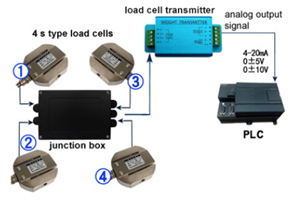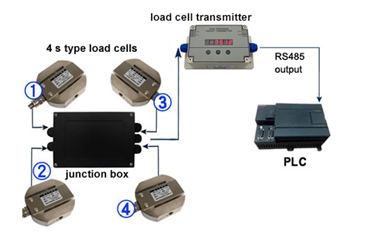 Force Sensor
Force Sensor
 Load Cell
Load Cell
 Torque Force Sensor
Torque Force Sensor
 Multi-axis Force Sensor
Multi-axis Force Sensor
 Piezoelectric Force Sensor
Piezoelectric Force Sensor
In our load cell product pages, when we introducing the load cells, we often say that you can buy a transmitter/amplifier with a customized output signal (0-5V, 0-10V, 4-20mA) to output standard signal to PLC, DCS and other control systems. Then someone will ask us how to connect load cell to plc. Now today we will explain the connection methods of load cell in details.
When forming the weighing and batching control system with PLC, there are four connection methods for load cell.
Method 1. Load Cell + Load Cell Junction Box + Load Cell Transmitter + PLC Analog Input Module
Generally, the signal output of load cell is a millivolt level voltage signal proportional to the weight/load, and the analog input module of ordinary PLC can't directly process it. So additional analog load cell transmitter is required to convert the weak sensor signal into the standard industrial process signal of 0-10V (0-5V) or 4-20mA (0-20mA), thus being treated by the analog input module of PLC.

Advantages of method 1: Such a method is cheap and practical. It doesn't need to eliminate PLC and the system is flexible, easy programming and responds quickly.
Disadvantages of method 1:
1)Analog signal is easy to be interfered during transmission.
2)It is restricted by the resolution of PLC analog. We know that some measuring instruments have high accuracy, but when collecting through analog quantity, the accuracy received by PLC is far inferior to that of the instrument itself. For example, the accuracy of S type load cell is 0.03-0.05%FS, but when analog quantity is used for input, the accuracy may be greater than 0.1%FS.
3)Poor timeliness. The delay of analog input is slower than that of the other two methods, although the time difference is not large. It makes the precise measuring system unable to realize high precision weighing.
Method 2. Load Cell + Junction Box + PLC Load Cell Module
This method has the highest measurement accuracy among all load cell connection methods. It converts the mV signal of load cell in specific load cell module of PLC. In this way, it can not only retain the accuracy of load cell, but also realize high resolution, long distance transmission and quick response due to the specific extension module of PLC.
The disadvantage is that it needs to be equipped with PLC that can connect the weighing module, so the cost is relatively high. The debugging of weighing module and parameter setting are more troublesome than that of transmitter, and they needed to be recalibrated to ensure the accuracy after using for a period of time. After replacing the load cell, it shall also be recalibrated, so the operation is more difficult than the weighing transducer.
Method 3. Load Cell + Junction Box + Load Cell Amplifier (RS232/RS485 output)

The load cell amplifier with RS485 output will connect to PLC standard serial communication port. This method is between the above two methods, and integrates their advantages:
1)Using the communication method can improve the accuracy of measurement results, and the timeliness can also be set to make speed faster than analog input.
2)It omits the analog input module of PLC, so it's easy to maintain. And it can collect weighing signals according to the standard MODBUS protocol, and can also connect with several load cells in parallel at the same time.
The disadvantages are that it occupies the communication port of PLC and consumes the internal memory of PLC. If the timeliness of weighing results is to be guaranteed, we need to scan the RS232/485 communication port quickly, but the RS232/485 communication port occupies much internal memory, so if the program is more complex, the program will probably make the scanning cycle of PLC longer and the response slower. Due to the limitation of serial communication speed, the response time of the whole system is longer, which is generally tens of milliseconds. And some factories have once encountered similar problems. So factories shall select this method according to its actual conditions.
Method 4. Load cell + Junction Box + Frequency Output Load Cell Transmitter
The load cell transmitter will connect to the high speed pulse capture port of PLC. Advantages of such a connection method are that it eliminates the special analog input module of PLC and is suitable for long distance transmission, strong anti-interference ability, easy isolation and quick response speed.
Disadvantage is that the frequency output load cell transmitter is rare in the market. There are limited models for selection.
By the way, in the above diagram, the load cell junction box has 4 inlets and 1 outlet. It is used to connect 4 load cells. If you want to connect 8 load cells, remember to select '8 inlets to 1 outlet' when you are purchasing a BRANS junction box. If there is only one load cell in your weighing system, the junction box is unnecessary.
If you have already confirmed your weighing system module and connection method, just connect the load cell to plc directly by the appropriate method. If you are still considering it, it is best to make decisions based on the advantages and disadvantages of the above four methods combined with your system requirements, system costs and system maintenance.